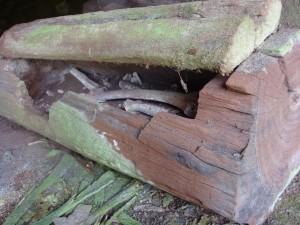In log coffins, first glimpses of a mysterious Asian people
Kevin Krajick / Columbia University
Source - http://phys.org/news/2012-05-coffins-glimpses-mysterious-asian-people.html

Dendrochronologist Brendan Buckley’s usual occupation is drilling straw-like cores from old trees and extracting information about past climates by studying their rings. To extend the record beyond the time of living trees, he sometimes takes samples from long-dead trees, or even from timbers in ancient buildings. In 2010, the Lamont-Doherty Earth Observatory scientist was part of a team that traveled into the remote Cardamom Mountains of southern Cambodia to investigate human burials contained in coffins carved from entire logs.
The group, led by Nancy Beaven of New Zealand’s University of Otago Medical School, traveled by boat, motorcycle and finally by foot through the forest to reach cliffs where burials lay. At one site, 20 feet off the forest floor was a ledge protected by an overhang, where lay a row hollowed-out logs, along with ceramic jars. Many held remains. There was a smell of bat guano. Some team members, including Cambodian archeologists, were nervous about offending the spirits of the dead, and before touching anything, they prayed to them to tolerate their intrusion.
Some of these sites have been known since the 1970s, but little study has been undertaken, and the locations of some have since been lost. To date the sites and study diet and other factors at the site Buckley visited, researchers took smalll samples of bones, soil, plants and other material. Buckley had hoped to extract sliver-width cores from the coffins to study their rings, but the caskets were too crumbly, and he had to settle with a few chunks half the size of a pinky, to be sent for radiocarbon dating. Whether the spirits were offended, no one is sure. But during the 10-day stay, Beaven broke her arm, and Buckley badly injured a shoulder; in the dark of some nights, wild elephants stormed the camp, and had to be driven off by lighting of torches and banging of biscuit tins.
According to a just-published paper by the team in the journal Radiocarbon, the wood and bone samples date to between 1395 and 1650 AD. This was concurrent with the decline and fall of the great Angkor empire, which ruled much of southeast Asia until around 1432. Buddhism was then the main religion of the region, but Buddhists practiced cremation, and these people did not. They seem to have been part of a separate, unidentified ethnic group that possibly lived in isolation, or may have been fleeing from the mainstream urban population who viewed them as savages, said Buckley. “This is our first real glimpse into who these people were,” he said.
Buckley has previously studied the fall of Angkor itself, by hiking into remote places of southeast Asia to find old trees, but this was his first mortuary expedition. You can hear sounds from the expedition on this Canadian Broadcasting Corp. segment from the Cardamom Mountains.